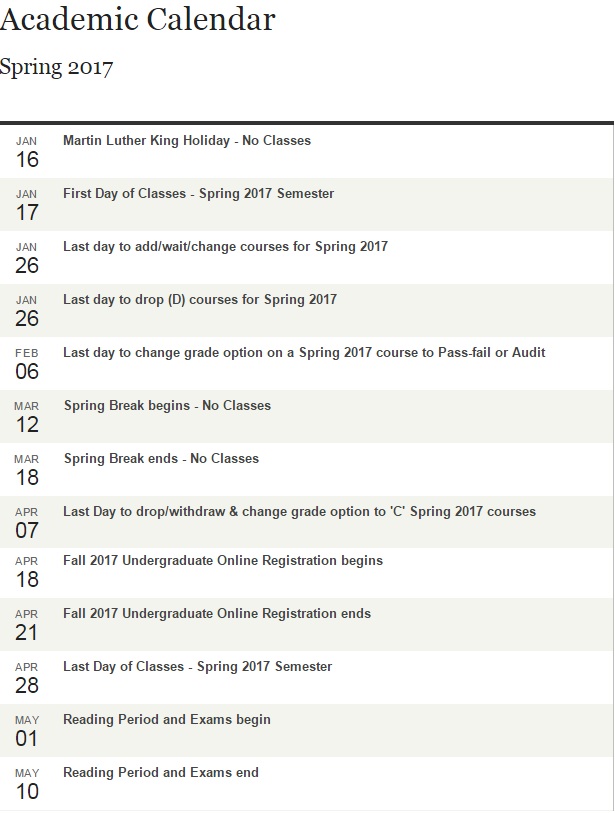Description: An elementary introduction to probability and statistics. Discrete and continuous random variables, mean and variance, hypothesis testing and confidence limits, nonparametric methods, Student's t, analysis of variance (ANOVA), (multiple) regression, contingency tables. Graphing calculator with statistical distribution functions (such as the TI-83) is required. Students considering a major or minor in mathematics should take Math 3200, NOT Math 2200. Examination Schedule: Tests, at which attendance is required, will be given from 6:30 to 8:30 p.m. on the following dates: Tuesday February 7, Tuesday March 7, and Tuesday April 4. Prerequisite: Math 131. Attributes: A&S: NS, QAA&S IQ: AN, NSMArch: NSMArt: NSM
In the weekly table below, LN refers to Lecture Notes and OS refers to OpenIntro Statistics". Adjustments to the table will be made periodically to reflect the actual pace of the lectures:
| Week | Sections | Suggested Problems |
|---|---|---|
| #1 (01/18, 01/20) | LN Chapter 1: Sections 1.1, 1.2, 1.3, 1.4, 1.5 | LN Chapter 1: 1-11 |
| #2 (01/23, 01/25, 01/27) | LN Chapter 2: Sections 2.1, 2.2, 2.3, 2.4 | LN Chapter 2: 1-10 |
| #3 (01/30, 02/01, 02/03) | LN Chapter 3: Sections 3.1, 3.2 | LN Chapter 3: 1-20 |
| #4 (02/06, 02/08, 02/10) EXAM: Tuesday, Feb 07 (Covers thru 02/03) |
LN Chapter 4: Sections 4.1, 4.2, 4.3 | LN Chapter 4: 1-8 |
|
#5 (02/13, 02/15, 02/17) |
LN Chapter 5: Sections 5.1, 5.2 | LN Chapter 5: 1-8 |
| #6 (02/20, 02/22, 02/24) |
LN Chapter 6 Section 6.1 (covered on exam) Sections 6.2, 6.3 (reading only, not covered on exam) |
LN Chapter 6: 1-5 |
| #7 (02/27, 03/01, 03/03) | LN Chapter 7: Sections 7.1-7.4 | LN Chapter 7: 1-32 |
| #8 (03/06, 03/08, 03/09) EXAM: Tuesday, March 07 (Covers through 03/03) |
LN Chapter 7: Section 7.5 LN Chapter 8: Section 8.1 |
LN Chapter 7: 33-44 LN Chapter 8: 1,2 |
| #9 (03/13-03/17) Spring Break (No Classes) |
|
|
| #10 (03/20, 03/22, 03/24) | LN Chapter 8: Sections 8.2-8.4 | LN Chapter 8: 3-10 |
| #11 (03/27, 03/29, 03/31) |
LN Chapter 9: Sections 9.1-9.4 | LN Chapter 9: 1-5, 7-18, 21-26 |
| #12 (04/03, 04/05, 04/07) EXAM: Tuesday, April 4 (Covers through 03/31, Section 9.3 inclusive) |
LN Chapter 9: Section: 9.5 LN Chapter 10: Sections 10.1-10.4 |
LN Chapter 9: 6, 19, 20 LN Chapter 10: 1-7, 11-13, 15, 22 |
| #13 (04/10, 04/12, 04/14) | LN Chapter 10: Sections 10.5-10.6 | LN Chapter 10: 8-10, 14, 16-21 |
| #14 (04/17, 04/18, 04/20) | LN Chapter 12 | LN Chapter 12: 1-6 |
| #15 (04/23, 04/25, 04/27) | LN Chapter 11 | LN Chapter 11: 1-6 |
| FINAL EXAMINATION | Thursday, May 4 3:30 PM - 5:30 PM |
Please verify in Course Listings |
6.Homework
Several homework sets will be assigned. Some of the homework will be done through Webwork, which is accessed through this link:Webwork
Fall 2014 was the first time Webwork was used at Washington University for a statistics course. (If you have had a calculus course here, then you know that we use it regularly for calculus courses.) My opinion is that the statistics exercises that are available are not as good as those that are available for calculus, and they are more problematic. Pay attention to specific alerts that you will receive by email.
7. Links to Exam History
The math department web-posts many exams. Here is the link to the page of departure for the department's archive of old exams: Old Exams in PDF format A caveat: Old exams sometimes cover different topics. Other instructors often ask questions that I would not (and doubtless vice versa). In any event, I have already used what I consider the best of these old exam questions as exercises in the posted notes. Exams I have previously written for this course can be found here: My old 2200 exams in PDF format. Because you may reasonably infer that I consider the questions on these exams to be excellent exam fodder, there is no reason for me to highlight them a second time by inclusion as exercises in the lecture notes.
8. Arts & Sciences Spring 2017 Academic Calendar
 |
Brian E. Blank
Department of Mathematics
Washington University in St. Louis
1 Brookings Drive
St. Louis, MO 63130
Phone: (314) - 935 - 6763
Fax: (314) - 935 - 6839
e-mail: brian@math.wustl.edu
Last Updated: 2 April 2017